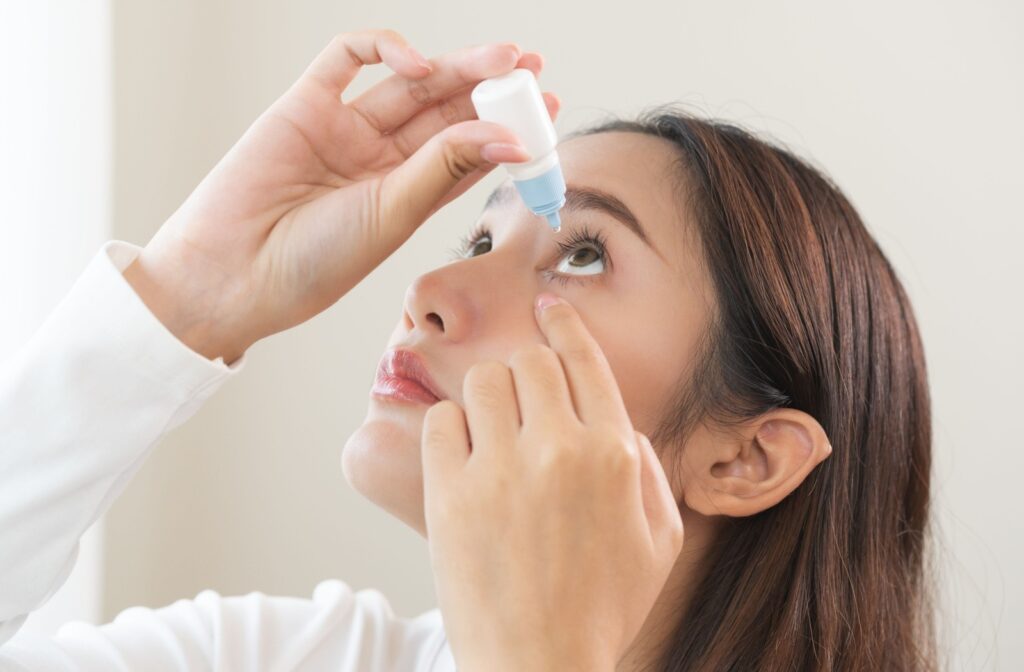You may feel a gritty, scratchy, or burning sensation in your eyes and wonder about the long-term effects. It’s a common concern—can chronic dry eyes lead to serious vision problems? The key is to manage the condition before it progresses.
While it’s very rare for dry eye disease to cause blindness, untreated chronic cases can lead to complications that damage your vision. We can help you find relief and protect your sight for years to come. Understanding the condition is the first step toward healthy, comfortable eyes.
What Is Dry Eye Syndrome?
Dry eye syndrome happens when your eyes don’t produce enough tears or when the tears evaporate too quickly. Tears do more than show emotion; they keep the surface of your eye smooth, clear, and protected. Without a healthy tear film, your eyes can feel uncomfortable, and your vision may suffer.
Common Signs of Dry Eye
Dry eyes can cause a variety of symptoms, and they often come and go throughout the day. Many people notice them after long periods of reading or staring at a screen. Common signs can include:
- A scratchy or gritty feeling, like sand is in your eye
- Redness and irritation
- Blurred vision, especially when you read or use a computer
- Sensitivity to light
- A feeling that you have something in your eye
- Watery eyes, which is the body’s response to the irritation
Factors That Contribute to Dry Eye
Your tear film has 3 layers: oil, water, and mucus. A problem with any of these layers can cause dry eye. Many factors can disrupt this delicate balance, from your environment to your daily habits. Contributing factors can include:
- Age, as tear production often slows down as we get older
- Environmental conditions like wind, smoke, or dry air
- Long periods of screen time, which reduce your blink rate
- Certain health conditions or medications
- Hormonal changes
How Dry Eye Affects Your Vision
While dry eye is often seen as just an irritation, it can have a real impact on how well you see. The health of your cornea, the clear outer layer at the front of your eye, depends on a stable tear film. Chronic dryness can put the cornea at risk and interfere with your daily life.
The Link Between Chronic Dry Eye and Vision Problems
When your eyes are persistently dry, the surface can become inflamed and damaged. This may lead to corneal abrasions or scratches on the eye’s surface. In severe cases, it can even cause open sores called corneal ulcers, which can lead to scarring.
Can Vision Loss from Dry Eye Be Reversed?
In many cases, vision blurriness from dry eye is temporary and improves with treatment. Once the tear film is stable again, your vision often returns to normal. However, if the cornea becomes scarred due to damage, that change can be permanent, highlighting the importance of early and consistent care.
The Real Risk: Complications from Untreated Dry Eye
The main message is that prevention is powerful. The journey from dry eye to vision loss involves a series of complications that you can often avoid with proper care. Blindness is an extremely rare outcome, but corneal damage is a real possibility with long-term, severe dry eye.
Think of it like caring for your skin. A little moisturizer prevents dryness and cracking. Similarly, managing dry eye helps protect the sensitive surface of your eye from damage. Consistent care is the best way to keep your eyes healthy and your vision clear.
Management and Treatment Options

The good news is that dry eye is a manageable condition. A combination of at-home care and professional support can provide significant relief and protect your long-term eye health.
At-Home Care and Lifestyle Changes
Simple adjustments to your daily routine can make a big difference. These small habits can help reduce symptoms and improve your eye comfort. They work best when combined with a professional care plan.
- Use artificial tears: Over-the-counter lubricating eye drops can offer quick, temporary relief.
- Take screen breaks: Follow the 20-20-20 rule. Every 20 minutes, look at something 20 feet away for 20 seconds.
- Control your environment: Use a humidifier to add moisture to the air and avoid direct wind from fans or vents.
- Stay hydrated and eat well: A diet with omega-3 fatty acids may support healthy tear production.
Professional Care for Lasting Relief
If at-home remedies aren’t enough, professional treatments can help. These may include prescription eye drops to reduce inflammation or in-office procedures designed to improve tear quality. A thorough eye exam can determine the source of your dry eye and the right course of action.
When to See an Optometrist
If you experience persistent dry eye symptoms, it’s a good idea to schedule an eye exam. If your vision becomes blurry, your eyes are constantly red, or you feel discomfort, please don’t wait. An optometrist in London, ON, can perform tests to check your tear quality and quantity.
We can identify the cause of your discomfort and recommend a personalized treatment plan. Our goal is to help you find relief and keep your eyes healthy for years to come. You don’t have to live with the discomfort of dry eye.
Our team at White Oaks Optometry is here to provide personalized care for your entire family, from your youngest child to your oldest relative. If you’re struggling with dry eye symptoms, let’s create a plan together. Contact us today to schedule your comprehensive eye exam.



